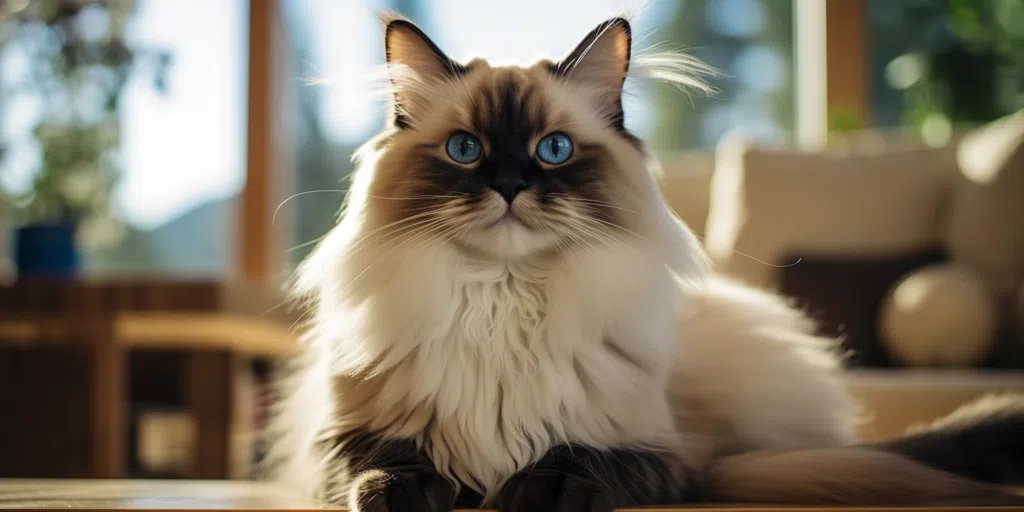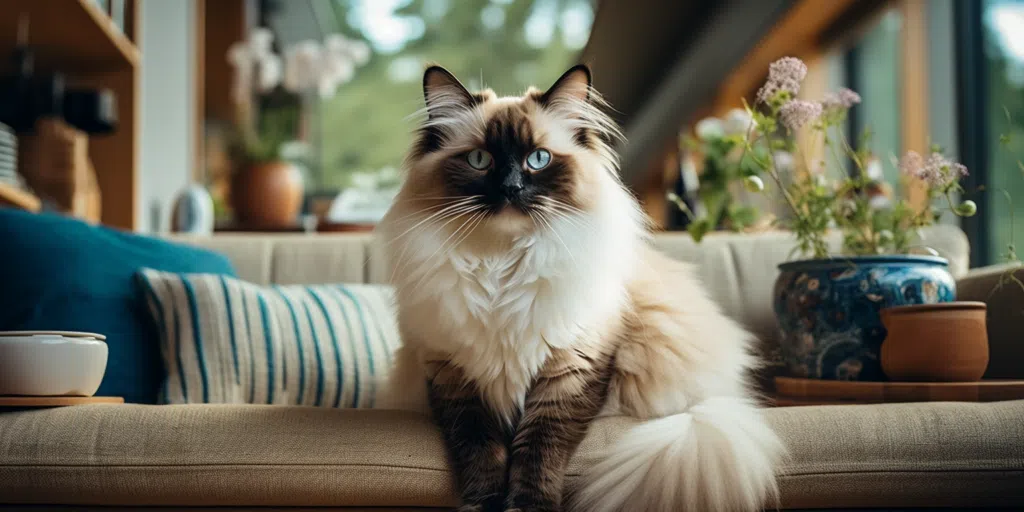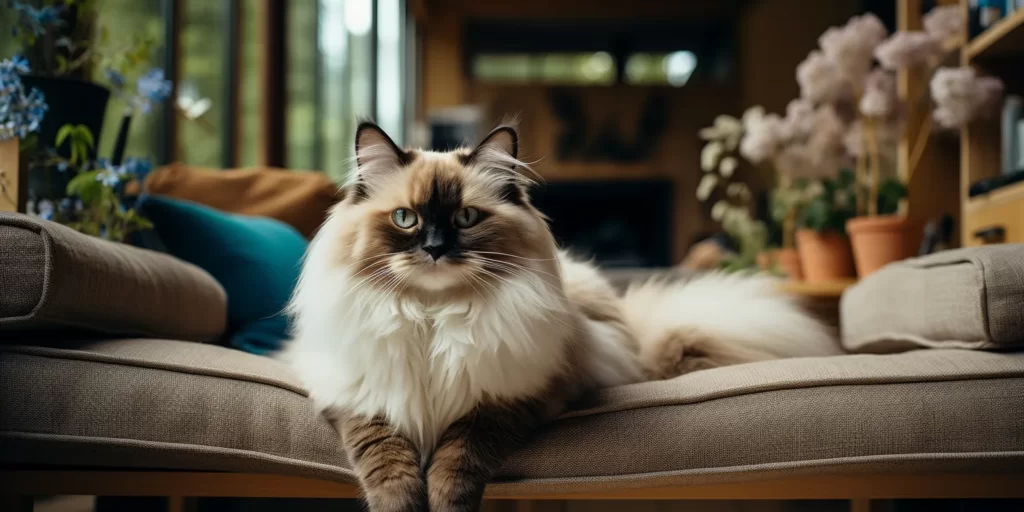Ragdolls are big, friendly cats that would make wonderful additions to any family. These cats adore being around people and will frequently follow their owners around the house simply to be by their side.
They are affectionate lap cats who enjoy nothing more than to curl up on a human’s lap and purr in return for any amount of cuddling. However, do not let that deceive you; these cats are just as entertaining when they are acting off!
Before you bring a Ragdoll Cat into your home, it is important to learn everything you can about their unique requirements and how to meet those needs.
Breed Overview

The Ragdoll cat is a large, long-haired breed that is recognized for its friendly demeanor and continuously patterned coat. They originated in Riverside, California, in the early 1960s and are thought to be descended from a white longhaired cat named Josephine.
Josephine, along with two males named Daddy Warbucks and Blackie, formed the foundation of the Ragdoll breed.
It’s believed that Josephine’s genes were altered at some point after she was hit by a car; after her return from the hospital, litters born had limp personalities, which became characteristic of this breed.
Ann Baker developed this breed and offered franchises to a handful of other breeders so they could continue developing the cats. However, due to her eccentric behavior, many of them distanced themselves from her.
Ragdolls need regular brushing sessions during shedding season and should also get regular checkups. They should also receive plenty of mental stimulation via interactive playtime activities.
Otherwise, boredom can lead these intelligent felines into destructive behaviors like scratching furniture, etc.
Related: 15 American Cat Breeds That Define the U.S. Feline Fancy
Identifying Ragdoll Cat
Ragdoll cats are a truly remarkable breed, boasting long and silky fur that is incredibly soft to the touch, almost resembling the texture of a rabbit’s fur. These beautiful felines come in distinct patterns like: colorpoint, mitted, and bicolor, each with their own special characteristics that make them truly unique.
Ragdoll cats have a delicate figure with gentle curves and transitions that emphasize their big eyes. Their fluffy coat adds to their irresistible charm.
What sets these cats apart is their unique blend of beauty and personality. They are renowned for being affectionate giants who seek attention from everyone they encounter. It is nearly impossible not to be smitten at first glance!

Ragdoll cats offer a delightful array of color variations to choose from. You will find options like seal, blue, chocolate, lilac, red, cream, cinnamon, and fawn, allowing you to select the perfect color and pattern to suit your preferences.
These cats are often sought after for their stunning dark faces and lighter-colored bodies. Their eyes always have a captivating blue hue. Ragdolls can also have tortie markings and lynx stripes, which contribute to their distinctive appearance.
No matter the mix of colors they possess, these cats have a stunning appearance that makes them stand out from other breeds.
Personality Traits
Ragdoll cats are known for their incredibly relaxed and loving personalities. They absolutely adore being cuddled and have a tendency to go completely limp in your arms, just like a stuffed doll. While they may not be the most active or talkative cats, they can still surprise you with bursts of playfulness and energy.
These cats are incredibly intelligent creatures who can easily learn tricks such as playing fetch or simple commands. As if that wasn’t enough of an amazing trait to appreciate, Ragdoll cats also have a very tolerant attitude toward their owners.
They seem to be endlessly grateful for any amount of attention their owners shower them with, and they love nothing more than to spend time cuddled up with their owners, whether it is reading a book on your lap or just relaxing at your feet while you get things done.
This breed is also known for having an incredibly gentle nature, especially in households with children of all ages. Not only do they rarely use their claws when playing, but they’re also incredibly gentle and patient around children.
But just like with any pet, it is crucial to teach kids how to properly handle pets so that the cat and the kid may stay safe while having fun together.
As long as the introduction is gradual and kept under control, ragdolls are usually fine with having other dogs or cats around the house.
With careful supervision, your Ragdoll should be able to form strong bonds with all members of your household.
Activity Level
Even though Ragdoll cats are known for their placid nature, it is important to make sure they get enough exercise by playing with interactive toys like balls, feather wands, catnip toys, and cat trees.
Keeping these cats active will also help to maintain a healthy weight. It is important to check your adult Ragdoll’s body condition regularly. Look along the spine and ribcage for optimal weight.
If there is excess fat around their lower abdomen, it could be a sign of obesity. It is important to ensure they have plenty of interactive playtimes!

Ragdoll Cat Loyalty
Ragdoll cats are famous for their incredible loyalty and devotion to their owners. They develop deep connections with the humans they share their lives with, often shadowing them throughout the house, much like a faithful canine companion.
Ragdoll cats are famous for their incredible loyalty and deep affection towards their owners. They develop strong connections with the people they live with, often shadowing them throughout the house, much like a faithful canine companion.
For those looking for an animal companion who will love them unconditionally, Ragdolls make very loyal companions indeed!
Love Of Water
Ragdoll cats are known for their kind and gentle nature, but you might be surprised to hear that these cats also love water. Many Ragdoll owners have raved about how much fun their cats had in the pool or on the beach.
It is really interesting how these cats do not seem to mind or get nervous around running water. In fact, they actually seem to enjoy it and actively seek it out for some fun! Whether it is taking baths in the bathroom sink or even swimming in pools, these cats rarely show any signs of fear or hesitation when it comes to water.
This makes them a unique breed among felines, who typically shy away from this element. For many Ragdoll owners, this helps make life easier by giving them an extra outlet for playtime activities that won’t leave your furniture soaking wet!
Trainability
Ragdoll cats are incredibly trainable, which makes them an ideal choice for pet owners who love teaching their feline companions new tricks. These intelligent cats can easily learn to play games like fetch and hide-and-seek with their human companions, ensuring endless hours of fun and amusement.
Because of their extroverted nature and love of being around people, ragdolls may be trained to learn new tricks with lots of love and positive reinforcement, much like dogs.
They are incredibly intelligent creatures, which makes them easily trainable; they often learn how to open doors or windows through observation alone!

Adult Size
The Ragdoll is a majestic and beautiful breed of cat that can reach impressive heights and lengths. On average, these cats can stand anywhere between 8 to 11 inches depending on their gender.
This charming breed typically weighs 8 to 20 pounds at maturity and has an average body length of about 18 to 22 inches.
The growth rate of ragdoll cats varies throughout their lives, but it is generally moderate and steady. From birth until around four months of age, the kittens put on approximately half a pound of weight every week.
When it comes to weight gain, Ragdolls take a little more time after four months and often reach full size between six and nine months. After that, they will keep adding a few pounds annually until they reach maturity, which is approximately three years old.
Life Expectancy
These cats have relatively long life expectancies, they can live up to 12–15 years. However, genetics and proper care influence how long they live.
Providing your cat with nutritious food rich in protein is essential for maintaining their health and vitality as they age. It is also crucial to schedule regular check-ups with a veterinarian to promptly address any potential health concerns before they escalate.
Keeping your Ragdoll in top shape involves incorporating exercise into their daily routine. It is important to make time for play and mental stimulation to keep their muscles toned and their minds engaged.
Ragdoll Cat Care
Ragdoll cats are not hard to take care of, but they do require grooming and attention on a regular basis to keep them looking good and healthy.
It is recommended to brush your cat twice a week to remove dead hair that can cause tangles. When brushing, be sure to pay particular attention to the areas where the legs meet the body, since this is where mats are most likely to be found.
Depending on how oily or stringy your cat’s coat looks, you should bathe it as needed, which is often every few weeks or months. Do not forget to brush your cat’s teeth, either!
To keep your cat’s gums and teeth healthy, brush their teeth at least twice a week. Other critical pet care tasks include trimming their nails every two weeks and washing their eyes with a moist towel every day.
As they grow, make sure they have plenty of food available so they can develop without internal or external problems. Keeping them indoors only is also recommended so that you can ensure their safety from outdoor dangers such as cars and other animals like coyotes.
Diet
Nutrition is an important part of keeping your Ragdoll cat healthy. When it comes to feeding your Ragdoll, the best way to start is by talking with your breeder and getting their recommendations on what type and brand of food will work best for them.
Be careful that your Ragdoll does not get overweight or obese, no matter what kind of food you give them. Obesity in cats causes diabetes and other major health problems, some of which can be fatal if not treated.
To keep them in the best possible shape, consult a veterinarian or look for a body condition scoring chart online; this will make it easy to monitor your pet’s weight change over time and make dietary adjustments as needed.

When it comes to selecting foods for your Ragdoll, it is important to ensure they get enough protein and fat. These nutrients are crucial for their growth and development.
Always consult a licensed veterinarian for more specific information if you suspect your cat is suffering from an eating disorder; doing so can help you avoid further complications.
It is important to make sure your cat has access to clean, fresh water every day. To keep your furry friend hydrated and in good health, you can set up multiple drinking spots throughout your home.
To ensure your cats stay hydrated, try placing their water bowl at least three feet away from their food. Cats have sensitive noses, and strong smells can sometimes discourage them from drinking enough water.
Exercise Requirement
Ragdolls are adorable little animals who love nothing more than snuggling up and taking long naps. However, it is important to remember that they still need some physical activity to stay healthy and happy.
Regular playtime is crucial for keeping your Ragdoll healthy and happy. It is important to provide them with opportunities to stay active and entertained.
Playing with toys is a great way to keep your furry friends entertained and mentally stimulated. It is also a fun way for them to get some exercise. Consider getting a cat tree or scratching post to encourage climbing, which will help keep them active and engaged all day long.
While playing with your Ragdoll, not only can you deepen your relationship with your cat, but you can also give them the mental and physical stimulation they need.
Shedding Levels
Ragdoll cats are known for their thick and luxurious coats, which can be quite a handful to care for. Like all long-haired cats, Ragdolls do shed hair, but the amount of shedding is usually less than in other long-haired breeds.
Do you have allergies? Is the Ragdoll Cat Hypoallergenic? Uncovering the Truth!
Grooming your Ragdoll cat on a regular basis can help minimize the amount of fur that your cat loses. When the season changes, this breed might shed more as it grows new fur to prepare for the winter or summer.
Health Issues
Ragdolls are generally a healthy breed, but they do have an increased risk of certain diseases. The most common diseases that Ragdoll cats are susceptible to include:
- Hypertrophic Cardiomyopathy (HCM)
- Calcium Oxalate Bladder Stones
- Feline Infectious Peritonitis (FIP).
HCM is the most common cause of heart disease in cats, so it’s important to select a reputable Ragdoll breeder who will do a DNA test for HCM on all cats they are breeding.
When calcium accumulates in the bladder, calcium oxalate bladder stones can form, and FIP is an infectious virus-based disease. To help ensure good health for your Ragdoll cat, be sure to provide them with quality nutrition and regular vet check-ups.
Poor diet and living conditions can also have a drastic effect on your cat’s health. Unhealthy diets lacking proper nutrition can lead to obesity, diabetes, heart disease, joint problems, and other ailments.
To keep your Ragdoll healthy and disease-free, it is essential to keep them clean and brush their fur as needed. Inadequate housing, exposure to severe temperatures, and an unsanitary environment are also potential causes of sickness in cats.
Buying Tips
- Look for a reputable breeder: When looking to purchase a Ragdoll kitten, it’s important to choose a reputable and experienced breeder who will ensure the health and well-being of their cats. Ask for recommendations from friends or other cat owners, as well as search online for reviews and testimonials about the breeder you are considering.
- Consider your lifestyle: Ragdolls can become very attached to their owners and need plenty of human interaction, so make sure that you have enough time each day to devote to your new pet before purchasing one.
- Ensure the kitten is healthy: Before bringing home your new kitty, have them examined by a veterinarian who can check them over for any potential issues such as parasites or diseases like Feline Leukemia Virus (FLV) or Feline Immunodeficiency Virus (FIV).
- Have appropriate supplies on hand: Make sure that you have all the necessary supplies ready before bringing home your new cat—this includes food bowls, litter boxes, toys, scratching posts and trees, etc.—so that they feel comfortable in their new environment right away!
Related: Amazing Ragdoll Cat Names & How To Select One!

Conclusion
Ragdoll cats are unique and loving pets that make great companions. With their gentle, affectionate personalities, they get along well with all members of the family, including children and other pets.
They have a sweet-natured disposition and enjoy being around people. They also require minimal grooming and maintenance to keep them healthy and happy. If you’re looking for an easygoing pet with an outgoing personality, then the Ragdoll cat might just be the perfect choice for you!